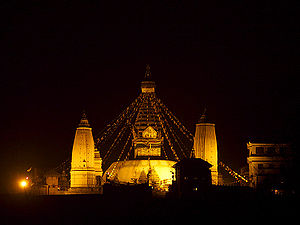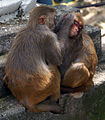- Swayambhunath
-
Part of a series on Tibetan Buddhism
History Timeline · Related-topics Schools Nyingma · Kagyu · Sakya · Gelug · Bön · Jonang Key concepts Three marks of existence · Skandha · Cosmology · Saṃsāra · Rebirth · Bodhisattva · Dharma · Dependent origination · Karma Major figures Gautama Buddha · Padmasambhava · Je Tsongkhapa · Dalai Lama · Panchen Lama · Lama · Karmapa Lama · Rinpoche · Geshe · Terton · Tulku Buddhahood · Avalokiteśvara · Four stages of enlightenment · Tantric yoga · Paramitas · Meditation · Laity Changzhug · Drepung · Dzogchen · Ganden · Jokhang · Kumbum · Labrang · Mindroling · Namgyal · Narthang · Nechung · Pabonka · Palcho · Ralung · Ramoche · Sakya · Sanga · Sera · Shalu · Tashilhunpo · Tsurphu · Yerpa Chotrul Duchen · Dajyur · Losar · Monlam · Sho Dun Texts Kangyur · Tengyur · Tibetan canon · Mahayana sutras · Nyingma Gyubum Sand mandala · Thangka · Ashtamangala · Tree of physiology Outline · Comparative studies · Culture · List of topics · Portal
Part of a series on
Buddhism
Dharma or concepts
Four Noble Truths
Five Aggregates
Impermanence
Suffering · Non-self
Dependent Origination
Middle Way · Emptiness
Karma · Rebirth
Samsara · CosmologyPractices
Three Jewels
Noble Eightfold Path
Morality · Perfections
Meditation · Mindfulness
Wisdom · Compassion
Aids to Enlightenment
Monasticism · LaityNirvāṇa
Four Stages · Arahant
Buddha · BodhisattvaTraditions · Canons
Theravāda · Pali
Mahāyāna · Chinese
Vajrayāna · TibetanSwayambhunath (Devnagari: स्वयम्भूनाथ स्तुप; sometimes romanized Swoyambhunath) is an ancient religious complex atop a hill in the Kathmandu Valley, west of Kathmandu city. It is also known as the Monkey Temple as there are holy monkeys living in parts of the temple in the north-west. The Tibetan name for the site means 'Sublime Trees' (Wylie:Phags.pa Shing.kun), for the many varieties of trees found on the hill. However, Shing.kun may be a corruption of the local Newari name for the complex, Singgu, meaning 'self-sprung'.[1] For the Buddhist Newars in whose mythological history and origin myth as well as day-to-day religious practice, Swayambhunath occupies a central position, it is probably the most sacred among Buddhist pilgrimage sites. For Tibetans and followers of Tibetan Buddhism, it second only to Boudhanath.
The Swayambhunath complex consists of a stupa, a variety of shrines and temples, some dating back to the Licchavi period. A Tibetan monastery, museum and library are more recent additions. The stupa has Buddha's eyes and eyebrows painted on. Between them, there is something painted which looks like the nose - but is the Nepali symbol of 'unity', in the main Nepali language dialect[citation needed]. There are also shops, restaurants and hostels. The site has two access points: a long stairway, claimed to have 365 steps, leading directly to the main platform of the temple, which is from the top of the hill to the east; and a car road around the hill from the south leading to the southwest entrance. The first sight on reaching the top of the stairway is the Vajra. Tsultrim Allione describes the experience:
We were breathless and sweating as we stumbled up the last steep steps and practically fell upon the biggest vajra (thunder-bolt scepter) that I have ever seen. Behind this vajra was the vast, round, white dome of the stupa, like a full solid skirt, at the top of which were two giant Buddha eyes wisely looking out over the peaceful valley which was just beginning to come alive.[2]
Much of Swayambhunath's iconography comes from the Vajrayana tradition of Newar Buddhism. However, the complex is also an important site for Buddhists of many schools, and is also revered by Hindus.
Contents
Mythology
According to Swayambhu Purana, the entire valley was once filled with an enormous lake, out of which grew a lotus. The valley came to be known as Swayambhu, meaning "Self-Created." The name comes from an eternal self-existent flame (svyaṃbhu) over which a sūpa was later built.[3]
Swayambhunath is also known as the Monkey Temple as there are holy monkeys living in parts of the temple in the north-west. They are holy because Manjushree, the bodhisattva of wisdom and learning was raising the hill which the Swayambhunath Temple stands on. He was supposed to leave his hair short but he made it grow long and head lice grew. It is said that the head lice had transformed into these monkeys.
The Bodhisatva Manjushri had a vision of the lotus at Swayambhu and traveled there to worship it. Seeing that the valley can be good settlement and to make the site more accessible to human pilgrims, Manjushri cut a gorge at Chovar. The water drained out of the lake, leaving the valley in which Kathmandu now lies. The lotus was transformed into a hill and the flower become the Swayambhunath stupa.
History
Swayambhunath, is among the oldest religious sites in Nepal. According to the Gopālarājavaṃśāvalī Swayambhunath was founded by the great-grandfather of King Mānadeva (464-505 CE), King Vṛsadeva, about the beginning of the 5th century CE. This seems to be confirmed by a damaged stone inscription found at the site, which indicates that King Mānadeva ordered work done in 640 CE.[3]
However, Emperor Ashoka is said to have visited the site in the third century BCE and built a temple on the hill which was later destroyed.
Although the site is considered Buddhist, the place is revered by both Buddhists and Hindus. Numerous king Hindu followers are known to have paid their homage to the temple, including Pratap Malla, the powerful king of Kathmandu, who is responsible for the construction of the eastern stairway in the 17th century.[4]
The stupa was completely renovated in May of 2010, its first major renovation in 90 years[5] and its 15th in the nearly 1,500 years since it was built. The dome was re-gilded using 20 kg of gold. The renovation was funded by the Tibetan Nyingma Meditation Center of California, and began in June 2008.[6]
Architecture
The stupa consists of a dome at the base, above which is a cubical structure painted with eyes of Buddha looking in all four directions with the word "unity" in the main Nepali dialect between them[citation needed]. There are pentagonal Toran present above each of the four sides with statues engraved in them. Behind and above the torana there are thirteen tiers. Above all the tiers there is a small space above which the Gajur is present.
Symbolism
The dome at the base represents the entire world. When a person awakes (represented by eyes of wisdom and compassion) from the bonds of the world, the person reaches the state of enlightenment. The thirteen pinnacles on the top symbolize that sentient beings have to go through the thirteen stages of spiritual realizations to reach enlightenment or Buddhahood.
There is a large pair of eyes onn each of the four sides of the main stupa which represent Wisdom and Compassion. Above each pair of eyes is another eye, the third eye. It is said that when Buddha preaches, cosmic rays emanate from the third eye which act as messages to heavenly beings, so that those interested can come down to earth to listen to the Buddha. The hellish beings and beings below the human realm cannot come to earth to listen to the Buddha's teaching, however, the cosmic rays relieve their suffering when Buddha preaches.
There are carvings of the Panch Buddhas (five Buddhas) on each of the four sides of stupa. There are also statues of the Buddhas at the base of the stupas. Panch Buddhas are Buddha in metaphorical sense in Tantrayana. They are Vairochana (occupies the center and is the master of the temple), Akshobhya (faces the east and represents the cosmic element of consciousness), Ratna Sambhava (faces the south and represents the cosmic element of sensation), Amitabha (He represents cosmic element of Sanjna (name) and always faces the West) and Amoghsiddhi (He represents the cosmic element of conformation and faces the north).
Each morning before dawn hundreds of Buddhist (Vajrayana) and Hindu pilgrims ascend the 365 steps from eastern side that lead up the hill, passing the gilded Vajra (Tibetan: Dorje) and two lions guarding the entrance, and begin a series of clockwise circumambulations of the stupa.
Gallery
-
Sadhu with 27 year old dreadlocks
-
Young girls spinning the prayer wheels
-
View on Kathmandu from the Swaymbhunath hill
See also
Footnotes
- ^ Allione, Tsultrim (1986). Women of Wisdom. London: Arkana. xxxiii. ISBN 1-85063-044-5.
- ^ Allione, Tsultrim (1986). Women of Wisdom. London: Arkana. xiv. ISBN 1-85063-044-5.
- ^ a b Shaha, Rishikesh. Ancient and Medieval Nepal. (1992), p. 122. Manohar Publications, New Delhi. ISBN 81-85425-69-8.
- ^ Lonely Planet Nepal (2005). Swayambhunath.
- ^ Shakya, Hem Raj. (2002) Sri Svayambhu Mahacaitya. Kathmandu: Svayambhu Vikash Mandala. ISBN 99933-864-0-5
- ^ Utpal Parashar (June 14, 2010). "Oldest Buddhist monument gets a makeover in Nepal". Hindustan Times. http://www.hindustantimes.com/Oldest-Buddhist-monument-gets-a-makeover-in-Nepal/Article1-557273.aspx.
Additional References
- Swoyambu Historical Pictorial. Edited by Richard Josephon. (1985). Satya Ho. Kathmandu.
- Psycho-cosmic Symbolism of the Buddhist Stūpa. Lama Anagarika Govinda. (1976) Dharma Books. Berkeley, California. ISBN 0-913546-35-6; ISBN 0-913546-36-4 (pbk).
Further reading
- Ehrhard, Franz-Karl (1989). "A Renovation of Svayambhunath-Stupa in the 18th Century and its History (according to Tibetan sources)." Ancient Nepal - Journal of the Department of Archaeology, Number 114, October-November 1989, pp. 1-8.
External links
- Swayambhunath Eyes by Tim van Woensel
- Swayambhunath Photos, October 2007
- Images from Swayambhunath
- Virtual visit to an interactive 3D model of Swayambhunath Stupa
- Swayambhunath images on flickr
- Swayambhunath at Sacred Destinations : Description of Sights and Icons
- Old video footage of Swayambhunath from 1978 AD
Coordinates: 27°42′54″N 85°17′24″E / 27.715°N 85.29°E
Buddhism Categories:- Temples in Nepal
- Buddhist temples in Nepal
- Nepalese culture
- Stupas
- Newar
- Buddhist pilgrimages
- Tibetan Buddhist places
- World Heritage Sites in Nepal
- Religious buildings completed in 1989
- 5th-century religious buildings
Wikimedia Foundation. 2010.

















